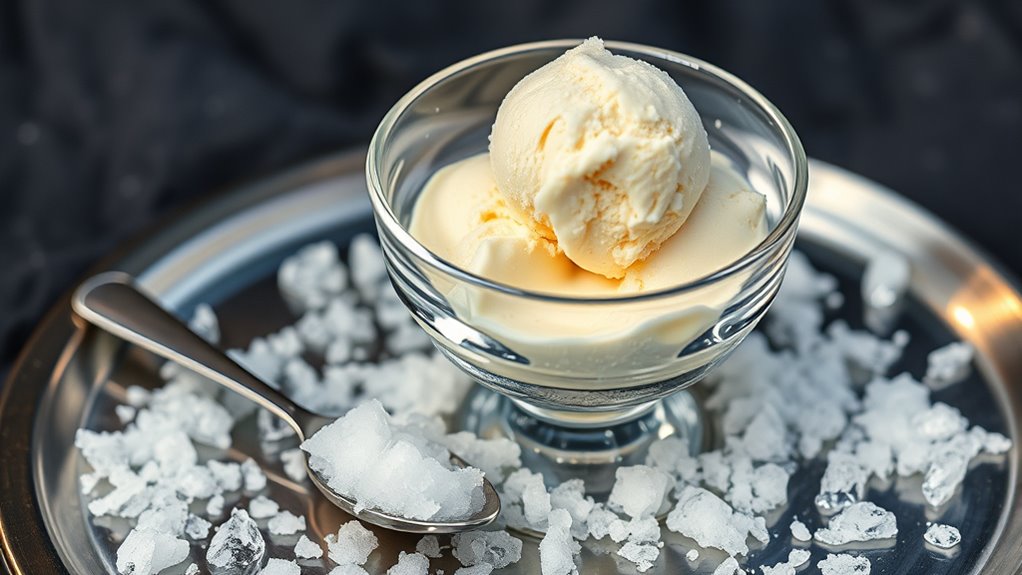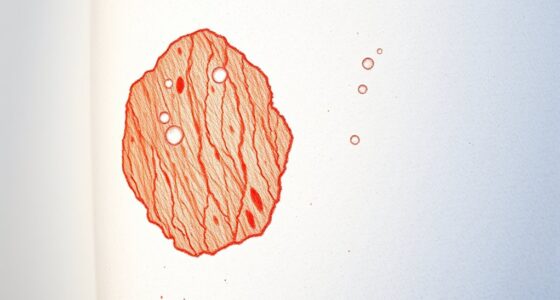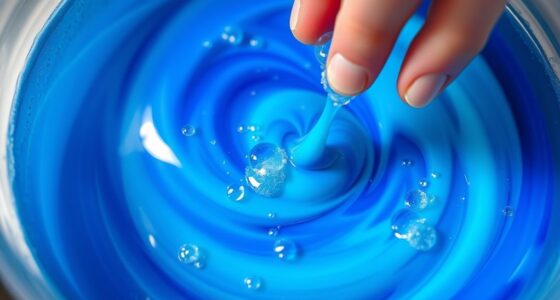When making ice cream, adding salt to the ice creates a salty brine that lowers its freezing point. This happens because salt molecules interfere with ice crystal formation, allowing the ice to stay liquid even at colder temperatures. As a result, the ice bath absorbs heat from your mixture more quickly, leading to faster and smoother freezing. Keep exploring to discover more science behind how salt makes your homemade ice cream perfectly creamy.
Key Takeaways
- Salt dissolves into ice, creating a salty brine that lowers the mixture’s freezing point.
- Lower freezing point allows the ice bath to reach temperatures below 32°F, speeding up cooling.
- Salt molecules interfere with water molecules, preventing ice crystal formation and maintaining liquid state.
- The depressed freezing point enables faster heat transfer from the ice cream mixture, resulting in smoother ice cream.
- Using salt in the ice bath is essential for achieving the proper texture and consistency in homemade ice cream.

Making ice cream at home isn’t just delicious—it’s a fascinating science experiment you can do yourself. When you mix ingredients and turn on your ice cream maker, you’re engaging with principles of freezing point depression and salt chemistry that explain why your homemade treat turns out perfectly creamy.
The key lies in understanding how salt interacts with ice and how it lowers the freezing point, allowing your mixture to chill faster and reach the ideal consistency.
Salt chemistry plays a vital role in this process. When you add salt to ice, it dissolves into the liquid, creating a salty brine. This brine has a lower freezing point than pure water, which means it can stay liquid at temperatures where fresh ice would normally freeze.
As a result, the temperature of your ice bath drops well below 32°F (0°C). This phenomenon, called freezing point depression, is a direct consequence of salt disrupting the formation of ice crystals. When salt molecules interfere with the orderly arrangement needed for water molecules to freeze, it effectively lowers the temperature at which ice remains solid. Understanding this freezing point depression is crucial for optimizing your ice cream process.
As you surround your ice cream mixture with this salty ice bath, the temperature drops rapidly. The salt chemistry guarantees that the ice stays in a liquid state longer, absorbing heat from the mixture more efficiently.
This process speeds up the cooling, letting your ice cream base freeze evenly and quickly. Without salt, ice alone would only cool your mixture down to 32°F, which mightn’t be enough to achieve that smooth, firm texture.
The salt’s ability to lower the freezing point means your ice cream mixture can reach temperatures around -5°F or even lower, depending on the amount of salt used.
Frequently Asked Questions
Does Adding Salt Affect the Texture of Homemade Ice Cream?
Adding salt to your homemade ice cream can cause texture alteration by making it creamier and smoother. Salt helps lower the freezing point, preventing large ice crystals from forming, which improves texture.
However, if you use too much salt, salt crystallization might occur, leading to grainy or gritty spots in your ice cream. To keep it perfect, add salt carefully and in moderation, ensuring a creamy, consistent texture.
Can Different Types of Salt Be Used for Better Results?
You can definitely experiment with different salt varieties to improve your ice cream. Each type has unique mineral content, which can influence how effectively it lowers the freezing point.
For example, kosher salt or sea salt often works better than regular table salt because of their purity and larger crystals. Trying various salts allows you to find the best mineral content for a smoother, creamier texture in your homemade ice cream.
How Much Salt Is Needed to Lower the Freezing Point Effectively?
To lower the freezing point effectively, you need the right salt concentration in your ice mixture. Typically, about 1/2 to 1 cup of salt per 4 cups of ice works well.
Adding too much can make the mixture overly salty and less effective. You want enough salt to disrupt the ice’s natural freezing point without overwhelming the mixture.
Adjust based on your recipe and ice amount for smooth, creamy ice cream.
Is Salt Safe to Use Around Children During the Process?
A picture’s worth a thousand words, so imagine salt as a sneaky visitor. Salt is generally safe around children if handled properly, but you should be cautious about salt ingestion.
Keep children away from direct contact with salt and avoid them eating large amounts during your ice cream-making. Always supervise, wash hands afterward, and store salt out of reach to guarantee child safety while enjoying your cool treat.
How Does Salt Impact the Overall Flavor of the Ice Cream?
You might wonder how salt impacts your ice cream’s flavor. Salt acts as a flavor enhancer, subtly modifying the taste by balancing sweetness and enhancing other flavors.
During the process, it can also influence the overall taste profile, making your ice cream more enjoyable. Keep in mind, using too much salt can lead to a salty aftertaste, so add it carefully to achieve the perfect flavor modification without overpowering the dessert.
Conclusion
Now that you know the salty secret behind super chilly science, you’re ready to craft cool creations with confidence. By blending boldness with basic biology, you bring brilliant, bubbly, and breathtaking ice cream ideas to life. So, seize the science, stir the spirit, and savor the sweet success of your salty, scientific snowstorm. With your newfound knowledge, you’ll master marvelous, mouthwatering masterpieces—making every icy indulgence an inspiring, unforgettable experience.









